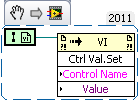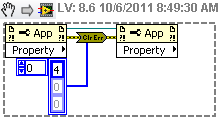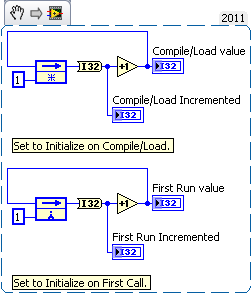-
Posts
548 -
Joined
-
Last visited
-
Days Won
25
Content Type
Profiles
Forums
Downloads
Gallery
Everything posted by crossrulz
-

Please help, Convert this string format to number
crossrulz replied to lovemachinez's topic in LabVIEW General
What version are you using? How did you do it before? As far back as at least 8.6 (I don't currently have older to check), all you should have needed is the Decimal String to Number. It will find the number even with all of the white space. -
Yeah, I was disappointed as well. They usually have such good ones too.
-
Oh, it has been that way for a long time. More recently I was browsing for information on being a Certified Professional Instructor and two hours later I get a call about it. Yes, NI logs everything we do on their site.
-

Developing OpenG while working for a company
crossrulz replied to crossrulz's topic in OpenG General Discussions
Under the Volume License Agreement, each developer is allowed a single home license. A license file needs to be created through the license manager that can then be installed on your home computer. -

Developing OpenG while working for a company
crossrulz replied to crossrulz's topic in OpenG General Discussions
I would have to go look at the agreement again, but I believe they own anything I do, even what is done in personal time. Well, there's also the discussion of whether or not my company thinks I truely have personal time (they can call me in for test failures at any time of the day or night), but that's another issue. -
I am interested in helping in developing OpenG. My problem is that I work for a company that automatically owns everything I do. I plan on making an agreement with them so that I can develop open source. I am an engineer, not a lawyer. Is there any advice for what should or should not be in such an agreement and any specific wording to be aware of?
-
I looks like when one clone is killed the FGV is reinitialized, meaning that the reference is lost. I haven't quite rationalized it in my head yet. But I have seen with other FGVs that if I just run it on its own and then run it again, the data is lost. I updated your VIs so that the controller handles maintaining the FGV and it worked just fine. DEWC.zip
-
I would definitely be interested. I'm mostly interested in how people get away with using OpenG in their projects since I'm planning on taking up that fight in the next year or so. Anything more would be bonus to me.
-
I'm assuming I'm supposed to reply here. I currently have permission to go and I just went ahead and registered. We'll see if I will really get to go. As far as OpenG, I currently am not using it for projects due to company rules about open source and third party code. I still find it to be a great resource though. I do have an interest in OpenG, whether using it or helping with development.
-

Change DAQmx Device Alias Programmatically
crossrulz replied to MerceanCoconut's topic in LabVIEW General
How about the actual VI saved in 8.0 ChangeAlias.vi -
You could use OpenG's "Get Current VIs Parents Reference" to get a reference to the main VI and then use an invoke node to get/set the control's values using their label. The other option at the top of by head is to make an array of the references to pass into the subVI and the index of which control changed. Then use a for loop to set the others.
-

CLA.. Exam was tough, so was waiting 3 weeks...
crossrulz replied to jdebuhr's topic in Certification and Training
Congratulations! I agree more time would be really nice to have with that exam. And I too am trying to convince my work to let me attend the summit (easier said than done). -
It's actually not a bug. The case structure is just not range inclusive for strings.
-

revision control and 3rd party add ons
crossrulz replied to JollyRoger7's topic in Source Code Control
The VIPC will install the version that is needed. So if the VIPC calls for version 1.0 and VIPM sees that version 1.5 is installed, V1.5 will be uninstalled and V1.0 will then be installed. From my understanding, you shouldn't just delete files that VIPM installed. Let VIPM uninstall the files. One of the beauties of VIPM is that packages can have dependencies so you can make sure you have all the code you need. -

closed review Filter Error Codes (Error Package)
crossrulz replied to Wouter's topic in OpenG Developers
I'm for the smaller icon personally. Since this VI is called "Clear Specific Error.vi", it should really be "Error Cleared?". For the error array VIs, would it make more sense for this indicator to be an array so the user can figure out which error was cleared? -

closed review Filter Error Codes (Error Package)
crossrulz replied to Wouter's topic in OpenG Developers
I just updated my second implementation from above to add a check for an empty array being passed in. So now all errors will be cleared if the array is empty (which is currently the default). Is this a desired feature to clear all errors? Clear error.vi -

closed review Filter Error Codes (Error Package)
crossrulz replied to Wouter's topic in OpenG Developers
I've had two versions of the array type. My first attempt uses a for loop. It has the added benefit/feature of inputting an empty array will remove all errors. My second attempt uses the Search 1D Array and check to see if the resulting index is greater than or equal to 0. This should be a little faster than comparing all of the array and OR the results. Similar to Shaun, I made the icons small so I can fit them between property nodes. -
I fully understand what you are talking about. I put together something that I was not proud of at all, but I still passed this last month. I could have sworn I put the stupid little comments for "Covers Requirement" for each requirement, but I still lost points there. Anyways, congratulations and I hope to see you at the summit (assuming I'm allowed to go).
-
Converted to 8.6 Find Arrary Element Clicked On.vi
-
I recently took the CLA (on the 2nd of this month). My proctor did tell me they changed the format for the CLD in giving the front panel. That could have saved me a good 10-15 minutes back when I took it. For the CLA, I was given the sheet of requirements and a blank USB drive for submission. I thought the CLA was one of the hardest tests I've ever taken, mostly due to the 4 hour requirement. And for what it's worth, I got my results yesterday and I passed!
-
Kudo up this idea: http://forums.ni.com/t5/LabVIEW-Idea-Exchange/Add-Variant-constant-to-the-Cluster-Class-amp-Variant-function/idi-p/1083987
-
Hit the diagram cleanup and you'll see exactly what your problem is. It would help you if you changed the direction of the fb nodes (right click option).
-
Are you dealing with an Invoke Node or a Call Library Function Node? If it is a CLFN, then just double click on the node and there should be a dll location control.
-
Just open the VIs in LabVIEW 2010 and save. There is also the mass compile option for a little more hands free. You might want to make a backup first just in case.








